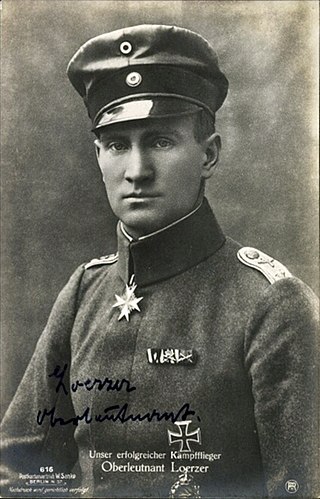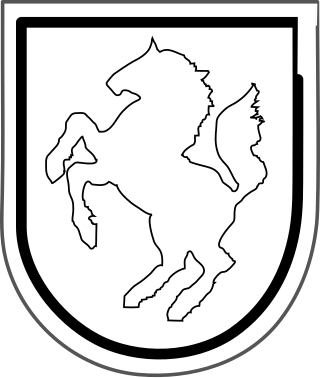
The VIII Fighter Command was a United States Army Air Forces unit of command above the wings and below the numbered air force. Its primary mission was command of fighter operations within the Eighth Air Force. In the World War II European Theater, its primary mission was air superiority. Its last assignment was with the United States Air Forces in Europe at RAF Honington,

Bruno Loerzer was a German air force officer during World War I and World War II. Credited with 44 aerial victories during World War I, he was one of Germany's leading flying aces, as well as commander of one of the first Imperial German Air Service Jagdeschwaders.
The Army Air Forces Tactical Center was a major command and military training organization of the United States Army Air Forces during World War II. It trained cadres from newly formed units in combat operations under simulated field conditions around which new combat groups would be formed. It was established as the Army Air Forces School of Applied Tactics (AAFSAT) in 1942 and redesignated the following year.

The 50th Troop Carrier Wing is an inactive United States Air Force unit. The wing was formed in 1941 as the 50th Transport Wing, a headquarters for air transport organizations of the Air Corps. In 1942, it became a training organization for troop carrier units deploying overseas. In 1943, it moved overseas, where its units participated in combat in the Mediterranean and European Theaters of Operations. Following V-E Day it remained in Europe until the fall of 1945. Its last assignment was with Third Air Force at Pope Field, North Carolina, where it was inactivated on 31 July 1946. It was redesignated the 50th Air Division in 1959, but was not activated.

Emil Lang, nicknamed "Bully", was a Luftwaffe flying ace during World War II. A flying ace or fighter ace is a military aviator credited with shooting down five or more enemy aircraft during aerial combat. Lang was credited with 173 aerial victories—144 on the Eastern Front, 29 on the Western Front—and one Soviet MTB sunk in 403 combat missions.

Jagdgeschwader 6 Horst Wessel was a Luftwaffe fighter wing during World War II. Created late in the war as one of the last Jagdgeschwader, JG 6 fought on the Western and Eastern Fronts and in the Defence of the Reich over Germany. This period of the air war was characterised by few successes and heavy losses among the German fighter arm.

Luftflotte 4 was one of the primary divisions of the German Luftwaffe in World War II. It was formed on 18 March 1939, from Luftwaffenkommando Österreich in Vienna. The Luftflotte was redesignated on 21 April 1945, to Luftwaffenkommando 4, and became subordinated to Luftflotte 6. It was the Luftflotte 4, that was responsible for the bombing campaign of Stalingrad, where ca. 40,000 civilians died. This Luftwaffe detachment was based in Romania, Bulgaria, Southeast Poland, Hungary, Ukraine and Russian occupied territories, for supporting Axis forces; with command offices in Morczyn, Hungary, during 26 June 1944, Eastern Front.
Luftflotte 3 was one of the primary divisions of the German Luftwaffe in World War II. It was formed on 1 February 1939 from Luftwaffengruppenkommando 3 in Munich and redesignated Luftwaffenkommando West on 26 September 1944. This Luftwaffe detachment was based in German-occupied areas of Northern France, the Netherlands, Belgium, and Vichy France, to support the Axis power's forces in area. Its command offices were in Paris, France.
2nd Fighter Division was one of the primary divisions of the German Luftwaffe in World War II. It was formed 1 May 1942 in Stade The Division was disbanded on 8 May 1945. The Division was subordinated to XII. Fliegerkorps, I. Jagdkorps and IX (J) Fliegerkorps.
1st Fighter Division was one of the primary divisions of the German Luftwaffe in World War II. It was formed on 1 May 1942 in Deelen from Stab/1. Nachtjagd-Division and redesignated 3. Jagd-Division on 15 September 1943. It was immediately reformed on 15 September 1943 in Döberitz from the 4. Jagd-Division. The Division was subordinated to XII. Fliegerkorps, I. Jagdkorps and IX (J) Fliegerkorps.
4th Fighter Division was one of the primary divisions of the German Luftwaffe in World War II. It was formed in August 1942 in Döberitz from the sub units of the 2nd Air Corps. The Division was redesignated 1st Fighter Division on 15 September 1943 and reformed 15 September 1943 in Metz from 3rd Fighter Division of the 2nd Fighter Corps. The unit was disbanded on 8 September 1944.
I. Jagdkorps was formed 15 September 1943 in Zeist from the XII. Fliegerkorps and the Luftwaffenbefehlshaber Mitte, and later subordinated to the Luftflotte Reich. The Stab relocated to Brunswick-Querum in March 1944 and to Treuenbrietzen in October 1944. The unit was disbanded on 26 January 1945 and its obligations were taken over by IX.(J) Fliegerkorps.
2nd Air Corps was formed on 11 October 1939 in Frankfurt am Main from the 2. Flieger-Division. During Operation Barbarossa and from 22 June to 12 November 1941, the Corps flew over 40,000 day and night sorties, dropping 23,150 tons of bombs and claiming 3,826 Soviet aircraft destroyed as well as 789 tanks, 614 artillery pieces, 14,339 vehicles, 240 enemy field positions, 33 bunkers, 159 trains and 304 locomotives along with relentless attacks on enemy troop concentrations and logistical choke-points.

X. Fliegerkorps was a formation of the German Luftwaffe in World War II, which specialised in coastal operations. It was formed 2 October 1939, in Hamburg from the 10. Flieger-Division.

Joseph "Beppo" Schmid was a German general who served in the Luftwaffe during World War II. Schmid commanded the Luftwaffe's Military Intelligence Branch during the Battle of Britain.

The 30th Infantry Division of the Wehrmacht was created on 1 October 1936 in Lübeck and mobilized on 26 August 1939 for the upcoming invasion of Poland. At that time, it consisted of the usual German infantry division elements: three infantry regiments of three battalions each, one three-battalion regiment of light artillery, one battalion of heavy artillery, a panzerjager (anti-tank) battalion, an aufklärungs (reconnaissance) battalion, a signals battalion, a pioneer (engineer) battalion, and divisional supply, medical, and administrative units.
II Army Corps was a corps in the German Army during World War II.

V Army Corps was a corps in the German Army during World War II.

The 376th Infantry Division was an infantry division of the German Army during World War II, active from 1942 to 1944 in two separate instances.
The LXVIII Army Corps was an army corps of the German Wehrmacht during World War II. The corps was initially formed in April 1943.










